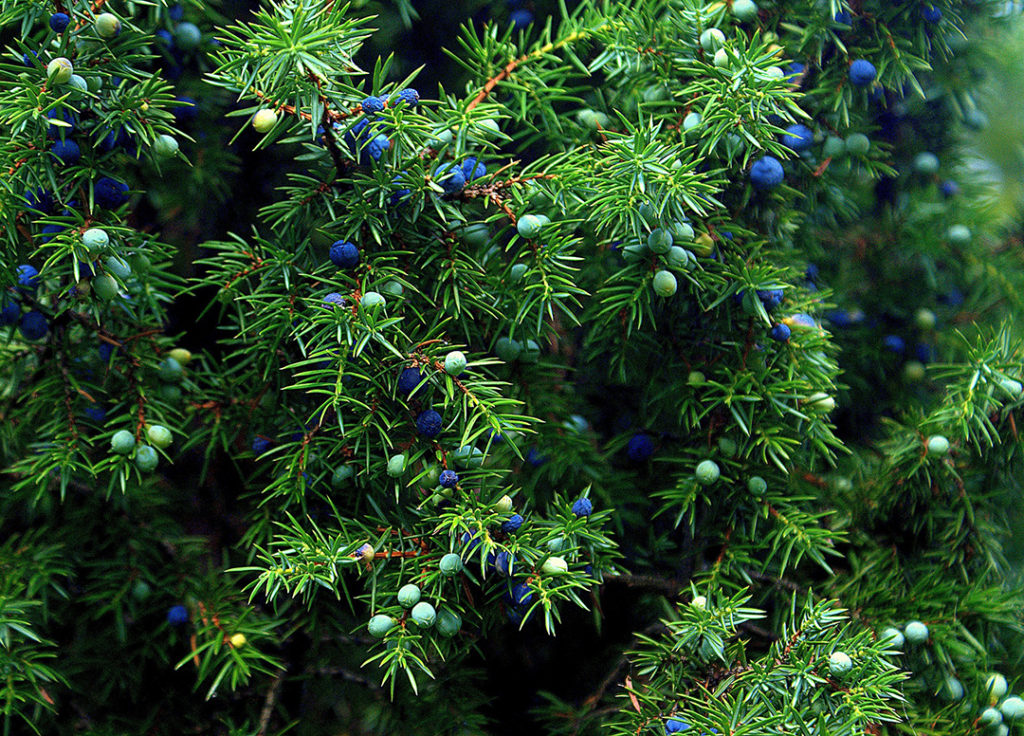
Bhutan
Juniper
Juniperus

General Description / Cultural Significance
The eastern Himalayan nation of Bhutan is covered in Juniper, Juniperus, forests. A high-altitude species which thrives on the mountainous landscapes of Bhutan, Juniper is so essential to the country’s environment and culture that is mentioned in the Bhutan national anthem. The oldest of pre-Buddhist beliefs claim the Juniper Tree is the abode and symbol of the goddess of fertility. To Bhutan locals, Juniper twigs are a symbol of life and to break one is symbolic of death. The incense of Juniper, also called Drukpas, is said to be the perfume of the gods, and Juniper branches are burnt as incense in the many monasteries and village houses of the Himalayas. The plant itself has dense branches and thick, scale-like leaves. The trees are often felled for religious purposes, primarily when a community member dies. Bhutanese people prefer to cremate bodies with freshly felled Juniper trees.
Bhutanese people look towards patterns in nature which have persisted throughout their ancient culture for indicators of their environment’s health. Every year, local people await the arrival of the cranes, a symbol that it is time to plant the winter wheat. Their high-pitched calls resonate through the valley. However, the stately Black-Necked Crane, so interconnected with the Bhutan environment, is now a Red Listed species. Even the sacred Juniper Tree is being watched carefully as its range shifts and its numbers drop due to harvesting intensity. These old growth trees represent not just a cultural significance for Bhutan, but critical importance to the world as carbon sequesters. The interconnectedness of Bhutan’s flora and fauna is sending out distress signals as the Juniper forests lose distribution, bird patterns change, and age-old environmental cycles are disrupted due to climatic warming.
Climate Change/Conservation Status
In 2012, the United Nations published their first World Happiness Report, an initiative proposed by the Prime Minister of Bhutan, who urged nations to rethink how they measure progress. Bhutan, a Buddhist country on the edge of the Himalayas, has had their own happiness index for decades. The head of the Center for Bhutan Studies and Gross National Happiness Research has said that looking exclusively at a country’s gross domestic product allows countries to miss out on larger moral truths, “that aggregate final optimal value which we call happiness.”
In Bhutan, the pursuit of happiness equates to the value of nature and the effect of clean air as a priority. Environmental preservation is cultural preservation. Bhutan is the only country in the world that is carbon negative, absorbing more carbon than it emits.
Some of the pillars of happiness include such sensorial pleasures as deep sleep, a forest walk and the country’s hot chilies, which came through India and established themselves as an important vegetable served as a main dish and loved for their hot flavor.
Because of rising temperatures brought about by climate change, Bhutan’s glaciers are receding at the rapid pace of 30-60 meters per decade. The water runoff is forming large glacieral lakes in some instances where Junipers once stood. Juniper is not listed as endangered, according to the IUCN Redlist, and hopefully it remains this way.
Alternate Names
Black juniper
Sources
Gari, M.T., et. al., 2020. Review on: Extraction of Essential Oil (Gin Flavor) from Juniper Berries (Juniperus communis). Extraction of essential oil. [website]
Höferl, M. et al., 2014. Chemical Composition and Antioxidant Properties of Juniper Berry (Juniperus communis L.) Essential Oil. Action of the Essential Oil on the Antioxidant Protection of Saccharomyces Cerevisiae Model Organism. Antioxidants (Basel), 3(1), pp. 81–98. DOI: 10.3390/antiox3010081
Jordans, B., 2006. Bhutan: A Trekker’s Guide. Cicerone Press, Milnthorpe, Cumbria
Kelly, A., 2012. Gross national happiness in Bhutan: The big idea from a tiny state that could change the world. The Guardian. [website]
Namgay, R., 2017. Estimating the range shift and harvesting intensity of Junipers in Bhutan (Eastern Himalaya). Theses. 315. University of Missouri, St. Louis.
Permanent Mission of the Kingdom of Bhutan to the United Nations. This statement can be found on the World Sensorium original website.
Seim, A., et al., 2016. Climate Change Increases Drought Stress of Juniper Trees in the Mountains of Central Asia. PLOS ONE, 11(4). DOI: 10.1371/journal.pone.0153888
UNDP, 2019. Climate Change Adaptation: Bhutan. United Nations Development Programme. [website]
Watkins, J., 2019. When Does a Juniper Bloom? SFGate. [website]

